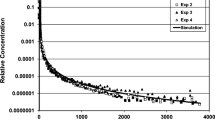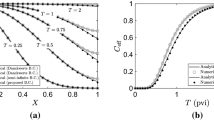Abstract
The time lag permeation technique has proven to bean effective method for characterisation. Because of the simple nature of the permeation experiment, transport parameters can be directly obtained from experimental data hence avoiding the intensive mathematical treatment required by other techniques. The method has historically been applied to diffusion and adsorption in porous membranes and diffusion in polymer membranes. Since its origins in 1920, interest in the time lag method has expanded because of its value in characterising simple permeation processes and also complex systems of diffusion with simultaneous adsorption and surface diffusion. This review focuses on presenting the asymptotic solution of the mass balance diffusion equations and includes applications of time lag analysis, in order to give a critical and broad perspective of this method as a tool for characterisation. It includes much of the previously published literature in order to show that for most cases the asymptotic solution of the transport equations is simple, and for more complex cases that an analytical solution is possible hence avoiding cumbersome numerical techniques.
Similar content being viewed by others
References
Shah, D.B., S. Chokchai-acha, and D.T. Hayhurst, “Measurement of Transport Rates of C4 Hydrocarbons Across a Single Silicalite Membrane,”Trans. Faraday Soc.,89(16), 3161 (1993).
Simon, A.M. and Z.J. Grzywna, “Time Lag Analysis of Mass Transport Through Catalytically Active Membranes,”Chem. Eng. Sci.,48(6), 1051 (1993).
Tsimillis, K. and J.H. Petropoulos, “Experimental Study of a Simple Anomalous Diffusion System by Time Lag and Transient State Kinetics,”J. Phys. Chem.,81, 2185 (1977).
Tshudy, T. and C. Von Frankenberg, “A Model Incorporating Reversible Immobilisation for Sorption and Diffusion in Glassy Polymers,”J. Polymer Sci. B,11, 2027 (1989).
Van Amerongen, G.J., “The Permeability of Different Rubbers to Gases and its Relation to Diffusivity and Solubility,”Journal of Applied Physics,17, 972 (1946).
Vieth, W.R.,Diffusion in and Through Polymers, Hansen Publishers, New York, 1991.
Vieth, W.R., I.M. Howell, and J.H. Hsieh, “Dual Sorption Theory,”Journal of Membrane Science,1, 177 (1976).
Vieth, W.R. and K.J. Sladek,J. Colloid Sci.,20, 1014 (1965).
Wang, C.T. and J.M. Smith,Chem. Eng. Sci.,34, 267 (1979).
Wicke, E. and R. Kallenbach,Kolloid-Z,17, 135 (1941).
Yasuda, H. and K.J. Rosengren, “Gas Permeability of Polymers,”J. Appl. Polym. Sci.,14, 2839 (1970).
Author information
Authors and Affiliations
Rights and permissions
About this article
Cite this article
Rutherford, S.W., Do, D.D. Review of time lag permeation technique as a method for characterisation of porous media and membranes. Adsorption 3, 283–312 (1997). https://doi.org/10.1007/BF01653631
Received:
Revised:
Accepted:
Published:
Issue Date:
DOI: https://doi.org/10.1007/BF01653631




